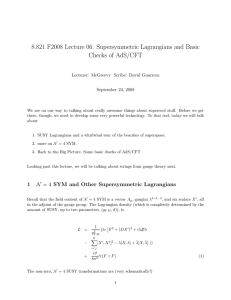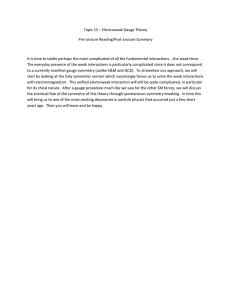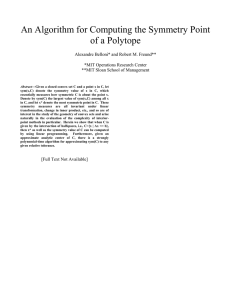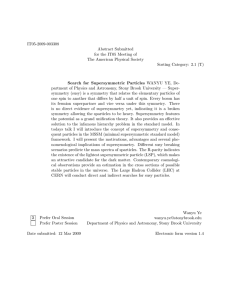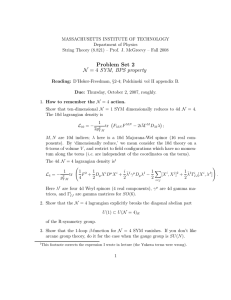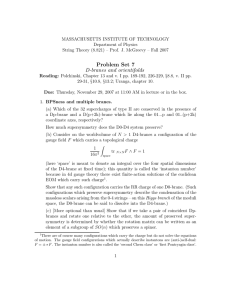8.821 String Theory MIT OpenCourseWare Fall 2008
advertisement
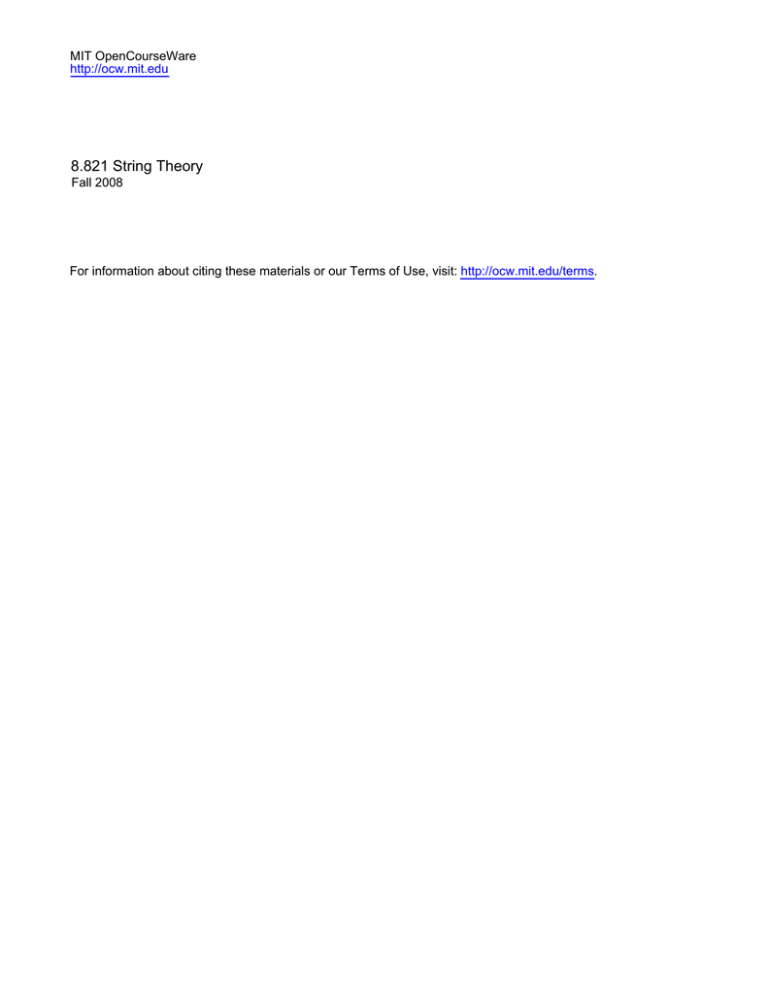
MIT OpenCourseWare
http://ocw.mit.edu
8.821 String Theory
Fall 2008
For information about citing these materials or our Terms of Use, visit: http://ocw.mit.edu/terms.
8.821 F2008 Lecture 06: Supersymmetric Lagrangians and Basic
Checks of AdS/CFT
Lecturer: McGreevy
September 24, 2008
We are on our way to talking about really awesome things about supercool stuff. Before we get
there, though, we need to develop some very powerful technology. To that end, today we will talk
about
1. SUSY Lagrangians and a whirlwind tour of the beauties of superspace.
2. more on N = 4 SYM.
3. Back to the Big Picture: Some basic checks of AdS/CFT
Looking past this lecture, we will be talking about strings from gauge theory next.
1
N = 4 SYM and Other Supersymmetric Lagrangians
Recall that the field content of N = 4 SYM is a vector Aµ , gaugini λI=1...4 , and six scalars X i , all
in the adjoint of the gauge group. The Lagrangian density (which is completely determined by the
amount of SUSY, up to two parameters, (gY M , ϑ)), is
L =
−
1
gY2 M
6
�
�
�
¯ Dλ
tr F 2 + (DX i )2 + iλ
/
[X i , X j ]2 − λ[X, λ] + λ̄[X, λ̄] ])
i<j
+
iϑ
tr(F ∧ F )
8π 2
The non-zero, N = 4 SUSY transformations are (very schematically!)
1
(1)
[Q, X] = λ
{Q, λ} = F + + [X, X]
{Q, λ̄} = DX
[Q, A] = λ
(2)
A Note: There are obviously indices and gamma/sigma matrices suppressed ALL over the place
(Lorentz vector, Lorentz spinor and SO(6) vector/spinor, supersymmetry). If you want to put the
indices in, either leave that as a fun exercise, or check out Weinberg, volume 3. As an example,
F + ≡ σ µν Fµν .
1.1
A Superspace Detour
The N = 4 SYM Lagrangian is an example of a (highly) supersymmetric Lagrangian. So far, I
just told you what it was and that it was SUSY invariant (something you could sit down in the
privacy of your office and check, if you wanted). It’d be nice, though, if there were some sort of a
machine that one could crank to generate supersymmetric lagrangians. That crankable machine is
superspace.
To understand why superspace is useful, we should think about why fields are useful for representing
translationally invariant Lagrangians in ordinary QFT. One reason is that the representations of
the translation group on the fields are particularly simple
φ(x) = eiP̂ ·x φ(0)
(3)
We’d like to introduce a superfield (that comes with its own supercapitalization) Φ(x, θ), which is
now a function of spacecoordinates x and “superspace” coordinates θ, that well represents transla­
tional invariance AND supersymmetry
Φ(x, θ) = eiP̂ ·x+iQ̂·θ Φ(0, 0)
(4)
where the Q̂′ s are the operators that generate supersymmetry transformations.
Now, in QFT, one can automatically get translationally invariant actions
S=
�
dd x L(φ, ∂φ)
(5)
as long as ∂x L = 0. Similarly the (here unproven) claim is that
�
dd x dN ·s θ L(Φ(x, θ))
2
(6)
is supersymmetric as long as ∂θ L = 0. Here s denotes the smallest (real) dimension of the spinor
representation in d dimensions and N , is, as usual the number of supersymmetries. Then N · s is
just the number of real supercharges. For example for N = 1, d = 4, N · s = 4, because either a
Weyl or Majorana spinor (the minimum in four dimensions) has four real components.
1.1.1
BPS or “Chiral” Multiplets
In lecture 5 we made a big deal about special representations of supersymmetry which are killed by
some of the supercharges. Such multiplets have correspondingly special properties in superspace.
Consider a field which satisfies
¯ Φ] = 0
[Q,
[Q, Φ] =
6
0
(7)
These multiplets, which are BPS (half of the supersymmetries annihilate them) are generally called
chiral multiplets. Sometimes they are actually chiral (in the sense of the Lorentz group), but often
times they are not. This follows a long tradition in physics of calling things other things which
they are not.
These multiplets are functions of only half of superspace as
Φ(x, θ, θ̄) = ei(Qθ+Q̄θ̄) Φ(x, 0, 0) = Φ(x, θ, 0)
(8)
Ok, well this equation is not exactly correct (as Senthil pointed out; really the RHS should be
¯ θ)), but it is morally correct: the Φ’s are functions of half of superspace. Because
Φ(y ≡ x + iθθ,
of this, it is possible to add terms to the Lagrangian density that are integrated over only half of
superspace and maintain supersymmetry:
ΔL =
�
d2 θ W (Φ) +
�
¯
d2 θ̄ W̄ (Φ)
(9)
Here, we are explicitly working in d = 4, N = 1 superspace. These terms are supersymmetric, as
long as W is a holomorphic function of Φ, ∂Φ̄ W = 0. With this constraint, W is a function we are
free to choose, and is known as the superpotential.
Two examples of a superpotential are
• The second line of equation (1). Here, we refer to the fact that this line can be written in
d = 4, N = 1 superspace (where we pick out a particular N = 1 subgroup from the N =4).
In a certain sense, one of the λ’s and F can be thought of as comprising one N = 1 chiral
multiplet, while the remaining three λ’s and six λ’s can be thought of as another three chiral
multiplets. The second line of equation (1) is a superpotential for these three chiral multiplets.
On pset 2 you will have a chance to think about this more precisely.
3
• The gauge kinetic terms and third line of equation (1) can be thought of as coming from the
N = 1 superpotential
�
d2 θ τ tr(λα λα )
(10)
where the λ appearing is the superpartner of F (α is a spinor index), and τ is a complexified
coupling constant τ ≡ g42πi + 2ϑπ . Here λ should be thought of as a superfield whose lowest
YM
component is the gaugino. The superfield expansion contains a λ = . . . θF term. Multiplying
two together, one gets
1
gY2 M
2
F ⊂
�
2
2
2
d θτ θ F ⊂
�
d2 θ τ tr(λα λα )
(11)
The rest of the gauge kinetic terms and theta angle term can be understood similarly.
1.2
Holomorphy and Non-Renormalization (aka Seibergology)
What’s the big deal with this newfangled “superpotential”?
Well, as we said before, the superpotential has to be holomorphic in order for supersymmetry to
be preserved. We can take this line of reasoning one step further–we can think of promoting the
couplings to dynamical superfields (whose lowest component vevs are just the constant couplings).
Then, the superpotential must be holomorphic, also, in the couplings.
This statement is uncomfortably powerful. For example, it implies that if SUSY is not broken, the
form of radiatively generated corrections to the superpotential are severely constrained–they must
be holmorphic in the fields and the couplings. For example, one could never generate a term in the
superpotential that was a function of both τ and τ̄ , W 6= W (τ τ̄ ).
This leads to many non-renormalization theorems in supersymmetric field theories, one example of
which is for the β function of supersymmetric gauge theories. This says that
βY M = 1 loop + non-perturbative
(12)
This makes sense because we know the theta angle cannot appear in the beta function perturba­
tively. However, since the effective gauge coupling function must be holomorphic in τ , the only
perturbative contribution to the beta function can be O(τ 0 ), i.e., the one loop contribution.
For N = 4 SYM, one can go home and calculate (for pset 2) that the one loop contribution to the
beta function is identically zero. In this theory, the non-perturbative terms can be understood as
coming from instantons. However, as it turns out, they do not correct the beta function, but do
add higher derivative terms elsewhere in the action1 . Hence, in this theory the beta function is
zero, even nonperturbatively, and the theory really is scale invariant.
1
This corrects a wrong statement from lecture 4.
4
For more on Seibergology, see the excellent notes of Argyres:
http://www.physics.uc.edu/∼argyres/661/index.html
2
Some More Comments on N = 4 SYM
1. It has a “Coulomb Branch of Vacua”:
The scalar potential in the N = 4 action (1) is:
V ∝
�
tr[X i , X j ]2
(13)
i,j
In general, supersymmetry is unbroken iff V = 0, and so there is a “moduli space” of supersymmetric vacua, labeled by vevs of X which satisfy
M = {X|[X i , X j ] = 0, ∀i, j}/{gauge symmetry}
(14)
We divide out by the gauge symmetry, since vacua related by gauge rotation are physically
equivalent. We can fix this gauge symmetry and satisfy the moduli space condition by picking
a basis such that
hX i=1,...,6 i = diag(xi1 , . . . xiN )
(15)
where N is the number of colors. Hence, the moduli space is just an 6 · N dimensional space
given by these x’s.
At a generic point in this moduli space xim 6= xin , and so the gauge bosons that commute
with each hX i i are all just proportional to the hX i i’s themselves, and so, at a generic point,
the gauge group is broken from U (N ) to the U (1)N subgroup generated by these. Since we
have broken to a whole bunch of copies of electromagnetism (with some charged scalars and
spinors), this moduli space is known as a Coulomb branch.
Since the vevs of the X’s give a mass scale, not only does a generic point in this moduli
space break the gauge symmetry, but it also spontaneously breaks the dilation, and hence,
the superconformal symmetry. The higgsing from U (N ) to U (1)N gives W -bosons with a
mass derived from this mass scale
ab
mab
W = |xa − xb | = Z
(16)
The W bosons are BPS objects with respect to the still-unbroken N = 4 supersymmetry.
This must be true since we said in lecture 5 that the N = 4 BPS massive multiplet (what we
have created by higgsing) has the same number of degrees of freedom as the N = 4 massless
multiplet (what we had before higgsing). The massless N = 4 gauge multiplet carries its food
around with it. The Z above are just the central charges of these BPS objects.
Recall also that this story has a D-brane interpretation: N = 4 SYM with gauge group U (N )
is the worldvolume theory of N (coincident) D3 branes. We can think about separating
these parallel N D3 branes. Since they are parallel, and sit in a ten dimensional spacetime,
5
there are six coordinates which label their positions: xia where i runs over the six transverse
dimensions and a runs over N , the number of D branes. Actually, to make sure the mass
dimensions of xia , match with those above, we write the separation between brane a and b as
i
Δyab
= α′ |xia − xib |
(17)
Recall, however, that when the D branes were coincident, we could interpret the lowest
(massless) string states which started on one D brane and ended on another as massless
gauge bosons for the U (N ) gauge theory. As we separate the branes, it is no longer the case
that strings stretched between branes are massless: they are stretched. Therefore, the gauge
bosons are acquiring a mass! In this context, the Higgs mechanism is just pulling a stack of
coincident branes apart–which is kind of superawesome. One can calculate the mass of these
W bosons, and not surprisingly they match with the picture above
1
Δyab = |xa − xb |
(18)
α′
The BPS property means that this relation must be true for any value of the string coupling.
mab
W = (string tension) x (length) =
2. S-duality (a.k.a. Montonen-Olive)
S-duality says the following absurd thing
1
[N = 4 with gauge group G, coupling τ ] = [N = 4 with gauge group L G, coupling − ]
τ
(19)
where L G is the “dual” gauge group, more on that in a second. As with many such dualities,
it says that these two theories are completely equal, though it might be hard to figure out
how to map the observables of one onto observables of the other. The dual group is defined
such that the weight lattice of L G is equal to the dual of the weight lattice of G
Γw (L G) = (Γw (G))∗
(20)
For example,
L
L
SU (N ) = SU (N )/ZN
SO(2N ) = Sp(N )
L
U (N ) = U (N )
(21)
The ‘L’ is for Langlands.
Really, S-duality is a subset of a larger duality that the theory enjoys: it is invariant under
shifts of the theta angle, ϑ → ϑ + 2π. These two transformations are usually called S and T :
S (ϑ = 0) : gY2 M →
16π 2
gY2 M
T : ϑ → ϑ + 2π
which together generate the group SL(2, Z):
6
(22)
(23)
aτ + b
, ad − bc = 1
(24)
cτ + d
There are many checks of this duality. For example, on the Coulomb branch, the theory has
BPS solitons whose spectrum matches that of the (perturbative) vector multiplet of the dual
group. Under an S transformation, the BPS solitons and vector multiplets switch.
τ→
3. Superconformal Symmetry
Supersymmetry and conformal symmetry combine (like Voltron) to form a larger spacetime
symmetry group, superconformal symmetry. In particular, the commutator of K (which
generates special conformal transformations) and Q (which generates supersymmetry trans­
formations) is nonzero (indices omitted)
[K, Q] = S
(25)
where S is a fermionic symmetry generator. So, although supersymmetry gave us 16 fermionic
symmetry generators, superconformal symmetry enlarges that to 32 fermionic symmetry gen­
erators.
3
Basic Checks of AdS/CFT
1. Symmetries
The two theories (IIB on AdS5 × S 5 and N = 4 SYM) enjoy all of the same symmetries
(as they should if they are the same theory!). For example
• SO(4, 2) × SO(6): We constructed the AdS5 metric such that it was SO(3, 1) invariant,
and also invariant under dilations. We will later see that this generates a whole SO(4, 2)
symmetry. The SO(6) symmetry is just rotations of the S 5 , which is its isometry group.
SO(4, 2) is also the (bosonic part) of the spacetime symmetry group for the SYM theory.
We have also seen in a previous lecture SO(3, 1) + dilations are symmetries of the SYM
theory (in particular, the dilation symmetry follows from the vanishing of the β function).
We will soon see how this too gets enlarged. The SO(6) symmetry here is the previously
discussed R-symmetry.
• 32 fermionic symmetries: Type IIB string theory (and supergravity) in flat space has
the maximum number of supercharges allowed, 32. As it turns out (and as will be
shown in the next problem set), the AdS5 × S 5 background does not break any of these
symmetries. Similarly, we have just remarked upon how the SYM theory has 32 fermionic
supercharges as part of the superconformal group.
• SL(2, Z): We have just remarked upon the N = 4 SYM SL(2, Z) duality. Similarly, this
0
strong-weak duality is also enjoyed by type IIB string theory. It acts on τ = gis + C
2π ,
where C0 is the Ramond-Ramond zero form. This makes sense, as the S transformation
in SYM acts on gY2 M whereas the S transformation here acts on gs – we have seen before
that we should identify these two quantities under the AdS/CFT duality.
7
2. Perturbations
The first claim each linearized supergravity perturbation corresponds to some N = 4 gauge
invariant operator. For now we focus on local operators, combinations of fields taken at the
same spacetime point. Since the operators are gauge invariant, they involve a trace, or prod­
uct of traces over SU (N ) indices. We’ll focus on single trace operators (the reasons for which
will be clear in a future lecture).
We can organize operator representations of the superconformal algebra by starting with
operators that are so called “superconformal primaries.” These operators O are annihilated
by both K and S
[K, O] = [S, O] = 0
(26)
We can then get other operators in the representation by acting with the operators Q and P .
Since, for a superconformal primary [S, O] = 0, it cannot be written as [Q, another operator].
Glancing at (2), this suggests that all superconformal primaries are built out of the X’s. In
fact, since commutators appear on the RHS of (2) only symmetric combinations of the X’s
will be superconformal primaries. Thus we are looking at operators of the form
Oi1 ...il ≡ T r(X {i1 . . . X il } )
(27)
On the supergravity side, fields (perturbations) on AdS5 × S 5 can be expanded in spherical
harmonics
on the S 5 . For example, using x as coordinates on AdS5 and y on the S 5 (with
� 2
y = 1), any field Φ(x, y) can be expanded as
Φ(x, y) =
�
φl (x)Y l (y)
(28)
l
and the spherical harmonics can be written as
Y l (y) = Ti1 ...il y i1 . . . y il |P y2 =1
(29)
The correspondence says that we should identify the spherical harmonics with superconformal
primaries as
Ti1 ...il y i1 . . . y il ←→ Ti1 ...il T r(X {i1 . . . X il } )
(30)
in a way that will be made precise in not too future lectures. This is enough to organize
the whole spectrum of supergravity perturbations. Since we know which supergravity fields
correspond to superconformal primaries, we can get descendant operators by acting with
Q and P . Similarly, we can get the supergravity perturbations that correspond to these
operators by acting with the corresponding symmetries in AdS5 × S 5 .
8
